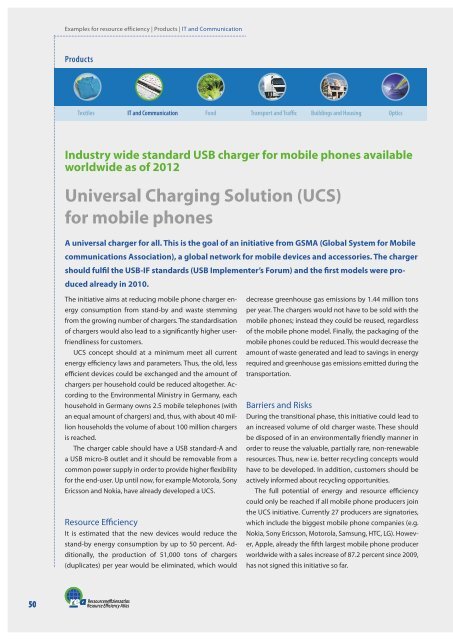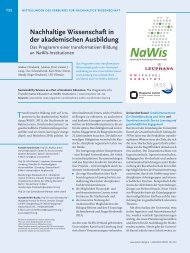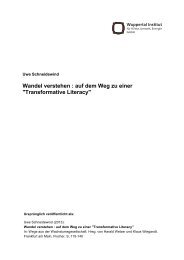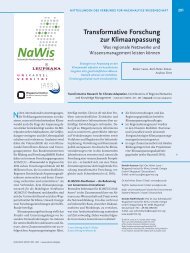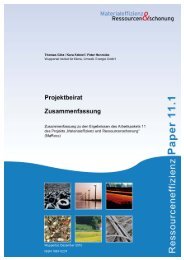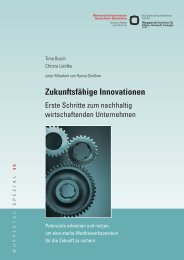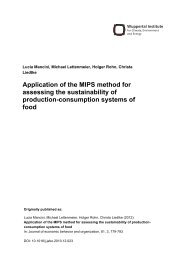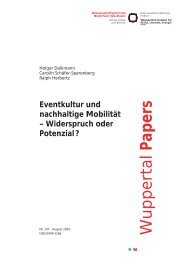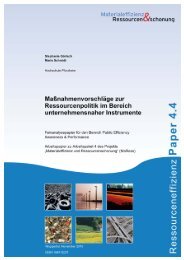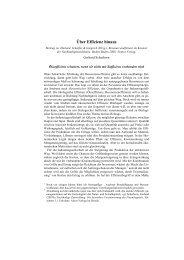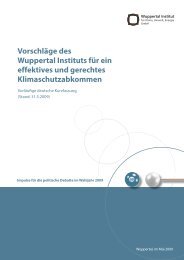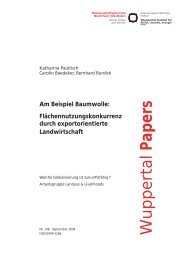Resource Efficiency Atlas - Publication Server of the Wuppertal ...
Resource Efficiency Atlas - Publication Server of the Wuppertal ...
Resource Efficiency Atlas - Publication Server of the Wuppertal ...
Create successful ePaper yourself
Turn your PDF publications into a flip-book with our unique Google optimized e-Paper software.
50<br />
Examples for resource efficiency | Products | IT and Communication<br />
Products<br />
Textiles IT and Communication Food Transport and Traffic Buildings and Housing Optics<br />
Industry wide standard USB charger for mobile phones available<br />
worldwide as <strong>of</strong> 2012<br />
Universal Charging Solution (UCS)<br />
for mobile phones<br />
A universal charger for all. This is <strong>the</strong> goal <strong>of</strong> an initiative from GSMA (Global System for Mobile<br />
communications Association), a global network for mobile devices and accessories. The charger<br />
should fulfil <strong>the</strong> USB-IF standards (USB Implementer’s Forum) and <strong>the</strong> first models were produced<br />
already in 2010.<br />
The initiative aims at reducing mobile phone charger energy<br />
consumption from stand-by and waste stemming<br />
from <strong>the</strong> growing number <strong>of</strong> chargers. The standardisation<br />
<strong>of</strong> chargers would also lead to a significantly higher userfriendliness<br />
for customers.<br />
UCS concept should at a minimum meet all current<br />
energy efficiency laws and parameters. Thus, <strong>the</strong> old, less<br />
efficient devices could be exchanged and <strong>the</strong> amount <strong>of</strong><br />
chargers per household could be reduced altoge<strong>the</strong>r. According<br />
to <strong>the</strong> Environmental Ministry in Germany, each<br />
household in Germany owns 2.5 mobile telephones (with<br />
an equal amount <strong>of</strong> chargers) and, thus, with about 40 million<br />
households <strong>the</strong> volume <strong>of</strong> about 100 million chargers<br />
is reached.<br />
The charger cable should have a USB standard-A and<br />
a USB micro-B outlet and it should be removable from a<br />
common power supply in order to provide higher flexibility<br />
for <strong>the</strong> end-user. Up until now, for example Motorola, Sony<br />
Ericsson and Nokia, have already developed a UCS.<br />
<strong>Resource</strong> <strong>Efficiency</strong><br />
It is estimated that <strong>the</strong> new devices would reduce <strong>the</strong><br />
stand-by energy consumption by up to 50 percent. Additionally,<br />
<strong>the</strong> production <strong>of</strong> 51,000 tons <strong>of</strong> chargers<br />
(duplicates) per year would be eliminated, which would<br />
Ressourceneffizienzatlas<br />
<strong>Resource</strong> <strong>Efficiency</strong> <strong>Atlas</strong><br />
decrease greenhouse gas emissions by 1.44 million tons<br />
per year. The chargers would not have to be sold with <strong>the</strong><br />
mobile phones; instead <strong>the</strong>y could be reused, regardless<br />
<strong>of</strong> <strong>the</strong> mobile phone model. Finally, <strong>the</strong> packaging <strong>of</strong> <strong>the</strong><br />
mobile phones could be reduced. This would decrease <strong>the</strong><br />
amount <strong>of</strong> waste generated and lead to savings in energy<br />
required and greenhouse gas emissions emitted during <strong>the</strong><br />
transportation.<br />
Barriers and Risks<br />
During <strong>the</strong> transitional phase, this initiative could lead to<br />
an increased volume <strong>of</strong> old charger waste. These should<br />
be disposed <strong>of</strong> in an environmentally friendly manner in<br />
order to reuse <strong>the</strong> valuable, partially rare, non-renewable<br />
resources. Thus, new i.e. better recycling concepts would<br />
have to be developed. In addition, customers should be<br />
actively informed about recycling opportunities.<br />
The full potential <strong>of</strong> energy and resource efficiency<br />
could only be reached if all mobile phone producers join<br />
<strong>the</strong> UCS initiative. Currently 27 producers are signatories,<br />
which include <strong>the</strong> biggest mobile phone companies (e.g.<br />
Nokia, Sony Ericsson, Motorola, Samsung, HTC, LG). However,<br />
Apple, already <strong>the</strong> fifth largest mobile phone producer<br />
worldwide with a sales increase <strong>of</strong> 87.2 percent since 2009,<br />
has not signed this initiative so far.


